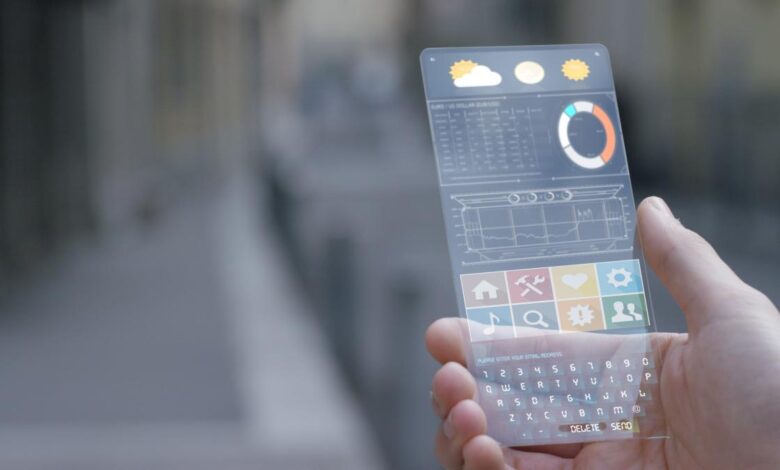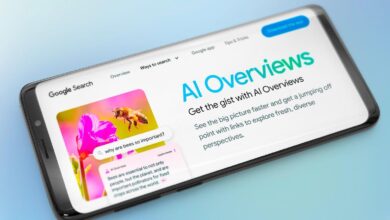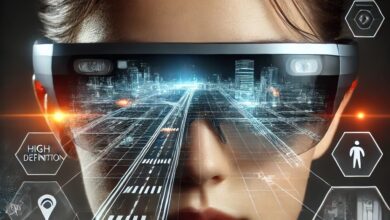The Future Smartphone Is Just a Display

For decades, the evolution of the smartphone has been a story of addition. We added cameras, fingerprint sensors, multiple lenses, faster processors, and more RAM. We’ve been on a relentless quest to pack more hardware into a sleek, rectangular slab. But what if the next great leap isn’t about adding more inside the device, but fundamentally reimagining the device itself? The most compelling vision for the future of mobile technology posits a radical shift: the smartphone will cease to be a complex box of components and will instead become a pure, sophisticated, and intelligent display.
This is not merely a prediction of thinner bezels or foldable screens. It is a fundamental re-conception of the smartphone’s role. The “brain” of the device will migrate to the cloud or specialized external hardware, while the “window” to that digital intelligence the display will become the sole physical interface we interact with. This article will delve deep into the technologies driving this transformation, the new forms it will enable, and the profound implications for how we live, work, and connect.
A. The Core Technologies Powering the Display-Centric Future
This seismic shift is not happening in a vacuum. It is being propelled by several converging technological revolutions, each reaching a critical point of maturity.
A.1. The Pervasive Power of 5G and Beyond
The rollout of global 5G networks, and the eventual advent of 6G, is the absolute bedrock of this future. These networks offer three critical features that make cloud-dependent devices feasible:
-
Ultra-Low Latency: This is the minimal delay in data transmission. For a display-smartphone to feel responsive, actions like touching the screen must yield an instant result, even if the processing happens miles away in a data center. 5G’s low latency makes this imperceptible to humans.
-
Massive Bandwidth: Streaming ultra-high-definition video, complex AR environments, and real-time data requires enormous amounts of data transfer. 5G provides the highway for this information to flow seamlessly.
-
Network Slicing: This allows carriers to create dedicated “virtual networks” for specific services, ensuring that your display-smartphone’s connection remains stable and prioritized, even in crowded areas.
A.2. Cloud Computing and Edge Computing Synergy
If the display is the window, then the cloud is the engine room. Powerful remote servers will handle the intense computational workloads from running operating systems and apps to processing complex AI algorithms.
-
The Cloud: Companies like Google, Amazon, and Microsoft operate vast data centers capable of hosting millions of virtual smartphones simultaneously. Your personal digital environment would simply be a containerized instance in the cloud.
-
Edge Computing: To reduce latency even further, processing will be handled closer to the user at the “edge” of the network (e.g., at local cell towers or mini-data centers in cities). This ensures that demanding tasks like real-time language translation or high-frame-rate gaming remain flawless.
A.3. Breakthroughs in Display Materials and Form Factors
The display itself will undergo a radical transformation, moving far beyond today’s glass slabs.
-
Foldables, Rollables, and Stretchables: We are already seeing the first generation of foldable phones. The next step will be displays that can roll out like a scroll (Rollables) or even stretch to change size and shape dynamically. Companies like Samsung, LG, and BOE are heavily investing in these technologies.
-
MicroLED and Advanced OLED: These technologies offer superior brightness, color accuracy, energy efficiency, and the ability to be made on ultra-thin, flexible substrates. MicroLED, in particular, is self-emissive and doesn’t require a backlight, allowing for incredibly thin and durable displays.
-
Transparent and Low-Power Displays: Research into transparent OLEDs and new low-power reflective displays (like advanced versions of E Ink) could lead to devices that can overlay information onto the real world or maintain a constant always-on state without draining the battery.
A.4. Advanced AI and Contextual Awareness
An intelligent display is useless without a brain to guide it. Artificial Intelligence will be the invisible hand that orchestrates the entire experience.
-
On-Device AI Chips: Even as processing moves to the cloud, specialized low-power AI chips will remain on the display device to handle sensitive tasks like facial recognition, voice wake-word detection, and contextual awareness, ensuring privacy and instant response.
-
Predictive and Proactive Assistance: Your device will learn your routines and anticipate your needs. It might automatically bring your boarding pass to the screen as you enter the airport, or translate a menu the moment you focus the camera on it, all powered by cloud AI.
A.5. The Miniaturization and Externalization of Components
The components that remain will be shrunk and re-engineered.
-
Under-Display Everything: The goal is to hide all components beneath the active display area. We already have Under-Display Cameras (UDC) in early stages. This will extend to speakers (using the screen as a vibration diaphragm for sound), advanced sensors, and fingerprint readers.
-
Advanced Battery Technologies: Solid-state batteries offer higher energy density in a smaller, safer package. Furthermore, with the computational heavy-lifting done in the cloud, the local device will consume significantly less power, allowing for smaller batteries or dramatically extended battery life.
B. The New World of Form Factors: Beyond the Slab
Freed from the constraints of internal bulky hardware, the design of our devices will diversify in astonishing ways.
B.1. The Ultimate Foldable: From Phone to Tablet
Foldable displays will become the norm, not a niche luxury. We will see devices that can seamlessly unfold from a compact 6-inch phone to a expansive 10-inch or even 12-inch tablet, providing a single device for all mobile computing needs.
B.2. The Rollable Display: Size on Demand
Imagine a device the size of a lipstick case that expands vertically or horizontally into a full-sized smartphone screen when you need it, and retracts for easy storage when you don’t. This offers unparalleled portability without sacrificing screen real estate.
B.3. Wearable Displays: The Wrist and Beyond
Smartwatches will evolve into primary devices, with flexible screens that wrap around the wrist, offering a much larger surface area. We might also see displays integrated into other wearables like smart rings that project an interface onto your hand, or even lightweight, fashionable glasses with built-in transparent displays.
B.4. The “Tab” or “Paper” Device
A thin, lightweight, flexible display that resembles a digital sheet of paper or a fabric bookmark. You could have several of these around your home, car, or office, each one a blank slate that instantly becomes your smartphone display when you pick it up, authenticated via biometrics.
C. The Profound Implications and Challenges
This shift to display-centric smartphones will reshape our technological landscape, but not without significant hurdles to overcome.
C.1. The Subscription-Based Everything Model
Ownership models will change. You may no longer “buy” a smartphone. Instead, you might subscribe to a service tier from a provider (e.g., Google, Apple, or a carrier) that grants you access to the latest cloud processing power and a physical display hardware upgrade every few years. This could make cutting-edge technology more accessible but also creates a perpetual payment relationship.
C.2. The Absolute Necessity of Connectivity
Your device becomes almost entirely dependent on a constant, high-quality internet connection. Dead zones or network congestion could render your display nearly useless. This creates a significant digital divide between well-connected urban areas and remote regions.
C.3. Enhanced Security and Privacy Concerns
With all your data and digital life residing in the cloud, securing that data becomes paramount. Providers will need to implement unbreakable encryption and robust multi-factor authentication. Users will have to place immense trust in these companies to protect their most sensitive information from breaches.
C.4. A Radical Shift in the Tech Industry
This model disrupts the entire supply chain. It could diminish the importance of traditional chipmakers like Qualcomm and Mediatek for end-user devices, while elevating cloud infrastructure companies like Amazon Web Services and Microsoft Azure. Device manufacturers would focus almost exclusively on display innovation, materials science, and design.
C.5. Environmental and E-Waste Considerations
On one hand, without a need for constant internal hardware upgrades, users could keep their display “slates” for longer, reducing e-waste. On the other hand, the environmental cost of massive, always-on data centers must be accounted for and powered by renewable energy.
D. The User Experience: A Glimpse into a Day in 2035
Let’s paint a picture of how this would work in practice. You wake up and pick up your flexible display tab from your nightstand. It recognizes your face and instantly connects to your personal cloud instance. Your home screen, apps, and data load instantly. You read the news on a large, paper-like display.
On your commute, you use a compact rollable device that fits in your pocket. You make a video call; the processing happens in the cloud, applying noise cancellation and enhancing the video quality from the simple under-display camera. At work, you dock your display into a larger screen and keyboard, instantly transforming it into a full desktop computer powered by the cloud.
After work, you unfold the device into a tablet to watch a movie, streaming in 8K resolution without any stuttering because the cloud is doing all the decoding. The entire experience is seamless, context-aware, and consistent across every form factor you touch.
Conclusion: The Invisible Computer and the Universal Canvas
The future of the smartphone is not about a better box. It is about the dematerialization of computing. The physical device in your hand will simplify into the most important part: the display. This transparent window to a cloud-based intelligence will become a universal canvas for information, communication, and creativity.
It promises a world of incredible flexibility, where our digital lives are no longer tethered to a single piece of hardware but flow effortlessly across any screen we encounter. While challenges around connectivity, privacy, and business models remain, the trajectory is clear. We are moving towards a future where the display is not just a component of the smartphone it is the smartphone. The revolution will not be internal; it will be visual.






